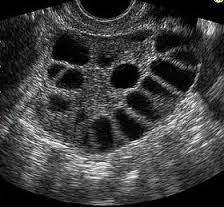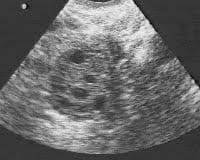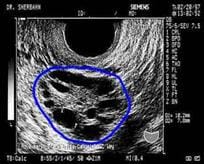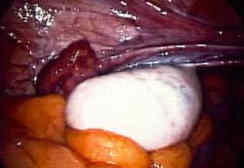Polycystic Ovary Syndrome (PCOS) is a condition which is characterized via largening and formation of a number of small cysts in the ovaries, which lead to some hormone related issues, and, the causes of which are not fully understood, yet.
The ultrasonography picture reveals small cysts in the ovary of a patient with polycystic ovary syndrome.
People with polycystic ovary syndrome may experience the following:

- Latent/infrequent menstruation (oligomenorrhea)
- Acne
- Obesity (being overweight)
- Excessive hairiness (hirsutism)
- Oocyte not released during menstruation (anovulation); thus, infertility.
When hormone tests are done on blood, a variety of conditions are visible; specifically LH (luteinizing hormone) and male related hormone (testosterone, DHEAS) levels will be high.
In this syndrome, the balance between FSH and LH hormones secreted by hypophysis (a section in the brain) and which regulate ovarian hormone production are damaged. As a result of this, anomalies in ovarian hormone production and ovulation can be seen.
Depending on the increase in male hormone levels, men-like hair formations might be observed in the body (especially on the face, breasts, around the belly and legs) whereas in some cases hair loss like those of men (local alopecia) are observed.
Another phenomenon of the condition is the absence of progesterone hormone production due to anovulation (no ovulation) while estrogen production continues. Secretion of estrogen alone may increase the risk of uterine cancer.
Symptoms of the disease start, typically, at puberty. Starting from the first menstruation, irregular menstruation, intense bleeding following latent menstruation are the first complaints. Such patients complain mostly of irregularities as latent menstruation.
Later on, men-like hairiness (hirsutism) is observed, in years. Starting as thin, tiny and a small number of hair on the chin and above the lips, they become thicker and numerous; thus, they create an aesthetic problem. During adulthood, “infertility” (not being able to have a child) may be added to the above conditions.
How is Polycystic Ovary Syndrome (PCOS) diagnosed?
PCO syndrome can be diagnosed by simply evaluating the patient’s complaints. During the physical examination male type hairiness (increased hair growth) is observed. Increase in hair growth is called “hirsutism” in medical literature. It is a condition depending on the effect of the increased male hormones.
In the ultrasound scan, numerous cysts, specific for the disease and not exceeding 3-6 mm in diameter are observed in addition to monitoring if there is ovulation. When no eggs are produced, this is called “anovulation”.
Additionally, the volume of the ovaries is increased; thus, the ovaries look larger than normal.
On the blood sample taken, increased levels of male hormone and LH/FSH ratio are observed.
How does polycystic ovary syndrome form?
There are many theories regarding the etiology (causes) of PCOS. Although not fully understood, today, the most common cause to blame is stated as “genetic features”. That is, PCOS is inherited through family genes.
However, outside factors like an unhealthy diet, no exercise and gaining weight can trigger the condition.
How is polycystic ovary syndrome treated?
In PCOS treatment, there is no one method that can fully cure the disease. Treatment is planned according to the needs of the patient.
In the case of irregular menstruation and excess hair growth birth control pills are very effective. In this type of treatment, male hormone production is suppressed. The aim is to stop the growth of excess hair. In order to start to see some results the patients need at least 6 months to a year.
Unfortunately, for excess hair grown earlier, there is no quick and effective way of medication treatment. For such hair, removal by using epilating wax or via electrolysis can be done. If hair is removed without taking birth control pills, the method will fail and removed excess hair will be replaced by stronger and more hair.
Since many women with polycystic ovary syndrome do not ovulate, they might face the issue of infertility. If a child is desired, the treatment should involve the use of medication aimed at producing oocyte (eggs). With such treatment, more than 80% of women with polycystic ovary syndrome can produce eggs.
Either for excess hair growth or for infertility treatment, the initial step to be taken involves losing weight under the supervision of a dietician. This is because it has been observed that hormone production can become normal following weight loss. The reason for this is that due to weight gain, the body starts a vicious circle regarding hormone production and the only way to break this irregularity is to lose weight. However, it is also possible that patients with PCOS are low weight people.
Medication for polycystic ovary syndrome is quite effective. However, if medication fails, a surgical intervention, ovarian drilling, to the ovaries via laparoscopic surgery can be done.
The picture on the left shows polycystic ovary observed during laparoscopy. As can be noticed, the outer part of the ovary looks white and is covered with a hard and thick layer. This layer, that stops ovulation, can be drilled during laparoscopy.
Even if patients with PCOS do not have any complaints, they should be given a treatment to reduce their possibly increased risk of uterine cancer and to help them have a regular menstruation.
Treatment against polycystic ovary syndrome should be continued for a long time because as soon as the suppression over the ovaries is removed, they start irregular hormone production and thus, the previous complaints start to form again.



